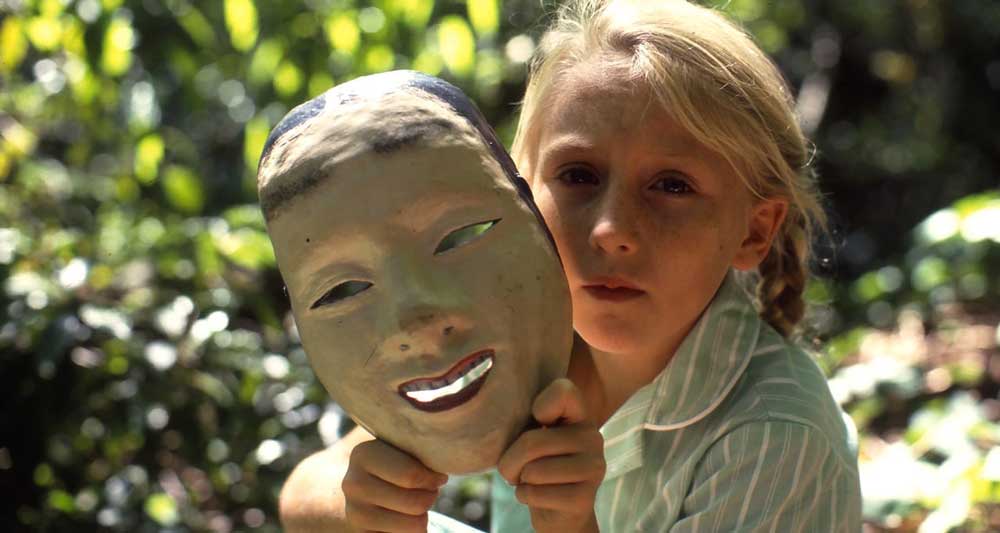Released in 1989, filmmaker Ann Turner’s debut feature Celia is another entry into the “fantastical coming of age” subgenre, which includes the baroque, playful fantasy of Jim Henson’s Labyrinth (1986), the bloody sexuality of Neil Jordan’s The Company of Wolves (1984), and any number of YA adaptations, successful, or not, that have (briefly) littered our screens over the past almost 20 years (taking the first Harry Potter film’s 2001 release as out ground zero, because why not?).
Celia bears more in common with Labyrinth and …Wolves due to Turner’s canny decision to blur the lines between fantasy and reality, externalising the title character’s confused and deeply symbolic imaginings as quasi-physical threats she must deal with. It’s all a bit Freudian, but Celia thrives because of its specificities. It’s set not only in suburban Melbourne, but in the 1950s, and Turner foregrounds two cultural elements from the period – the anti-Communist Red Scare and the rabbit plague – as not just narrative tools, but as psychological inroads into our protagonist. But we’re getting ahead of ourselves.
It’s the early 1950s, and nine-year-old schoolgirl Celia (Rebecca Smart) loves two things above all others: her grandmother and her pet rabbit, Murgatroyd. The former is taken from her when she discovers the old lady dead in bed one morning. The latter is under threat as the government institutes a ban on pet rabbits as part of an effort to stamp out the feral rabbit population, which is booming.
These two obvious traumas are paired with murkier troubles: the persecution of a neighbouring family who are suspected of being Communists, and the marital problems plaguing her parents (Mary-Anne Fahey and Nicholas Eadie). Fixating on The Hobyahs, a frightening story read to her class at school, in which an elderly couple are menaced by goblin-like monsters, Celia begins to imagine that the creatures are invading her life: behind every threat to normalcy and stability is a Hobyah in a human mask. And as fairy tales have told us since time immemorial, monsters must be bested with cunning and violence.
There are a few cultural touchstones that orbit around Celia, but none it maps directly onto. Its depiction of pre-helicopter-parenting childhood is absolutely on point, and echoes some of Stephen King’s better works on the subject (there’s even an Apocalyptic Rock Fight, ala IT). At one point Celia begins to incorporate imagery from a movie she’s seen at a Saturday matinee into her own personal cosmology, a riff that predates similar narrative flourishes in Peter Jackson’s Heavenly Creatures (1994) by several years. Weird little paganistic rituals that Celia and her friends enact, plus the red lipstick “warpaint” she dons for the film’s climax, allude to folk horror.
And yet the film remains singular – defiantly its own thing. Over the course of its life Celia has frequently been labeled a horror film – a hangover from its US home video release, when the distributor struggled to find a label for it that might attract audiences. And yes, there are horrific elements – the Hobyahs are realised as grotesque rubber-suit monsters, all spindly, clawed fingers and twisted, oily-black faces, and their intrusions into our protagonist’s mindscape are powerfully unsettling.
But its real horrors are social, political, and personal. What disturbs here is not the thought of painful death or toothsome creatures, but the way powerful cultural forces twist and buffet us in general, and young Celia in particular, and how we go to great lengths to construct meanings and systems of knowledge and belief to make some kind of sense of such processes. Within each adult is the child they once were, after all, and within that child still dwell the monsters that terrorized them. Celia manages to connect up all three, and few films have done so as effectively.
In this way, Turner’s film is more effective that any dozen more conventional genre works. It gets under the skin like a tick, like an infection, like myxomatosis, and lingers there, dully throbbing, driving us to pick at it and ponder, idly but worryingly, who our personal Hobyahs might be, and what rituals might best serve to fend them off.
Director: Ann Turner
Cast: Rebecca Smart, Mary-Anne Fahey, Nicholas Eadie
Writer: Ann Turner



